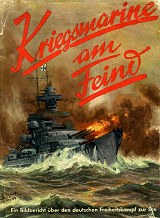 |
Home Intro Technical History Crew Models Gallery Kriegsmarine Archives
More Forum  UPDATES UPDATES |
June 5, 1941
The Naval Side of the War
By H. C. FERRABY
The story behind the scenes in the hunt for the Bismarck and the Prinz Eugen is as dramatic as anything in our naval history, but has been somewhat overshadowed in the general estimation through the emphasis laid by practically all the special correspondents on the grim and grisly scenes in the final moments. That kind of Dracularising of sea warfare may have been all very well for a populace that had no personal acquaintance with sudden explosive death. Today it strikes one as peculiarly repellent. In these notes I would like to offer another and different picture of that quite remarkable operation. It is built up from many scraps of information, gathered from responsible men. It will give, if my work is properly in perspective, the pattern of the net that was drawn rapidly and with extraordinary skill round the German battleship.
Let us begin with the broad outline. In an area of sea some 1,500 miles wide by 3,500 miles long two ships, each less than one-fifth of a mile in length, had to be found, and found by forces powerful enough to fight them. The British squadrons and units available were widely scattered in the area. The main body of the Home Fleet was somewhere in the region of the Faroe Islands, the Battle-Cruiser Force being to the northward of it. On the route from New York to the Western Approaches the battleship Rodney was engaged on convoy protection. Much further to the south-west, towards the Azores, the battleship Ramillies was also convoying. Most distant of all from the starting point of the operation was Admiral Somerville's Western Mediterranean Squadron based on Gibraltar. In the Western Atlantic was the aircraft carrier Victorious, and from their bases in the British Isles the aircraft of Coastal Command were carrying out their regular reconnaissance patrols to the north-east and to the west. That gives us five distinct naval forces afloat, separated from each other by as much as 3,000 miles in some cases, whose movements had all to be concerted to bring some at least of them in concentration on that elusive pin-point which was the Bismarck.
The Air Arm put out the first strands of the net by reporting the departure of the German ships from Bergen. One probable route, if they were making for the Atlantic, was round the north of Iceland through Denmark Strait. The cruisers Norfolk and Suffolk were detached to watch that area. The Home Fleet took up a central position south of Iceland ready to pounce east or west as necessary. For the time being the other forces were not concerned. The Norfolk and Suffolk made contact, and for thirty hours, part of the time alone, part of the time supported by the Prince at Wales, they kept the German ships in sight. That is a very simple phrase to write, but it was no simple thing to do. The weather was bad. Snow squalls swept clown every now and again, and then the cruisers had to close in to as little as one mile from the 15-in. guns of the Bismarck to keep her in sight. Why at such moments Admiral Luetjens left them alone is one of several inexplicable elements in his handling of the whole operation. And it may be noted, as a point of tactical interest, that, just as Admiral Harwood at the Plate disposed his ships on either side of the Graf Spee to prevent the quarry doubling on his tracks, so the Norfolk and Suffolk were disposed to port and starboard of the German ships. Whichever way Luetjens turned one or other of the ships would still be in position to shadow.
As soon as Admiral Tovey had the report of contact in Denmark Strait, he sent the Battle-Cruiser Force-including the battleship Prince of Wales-to cut across the southward track of the enemy. They, too, made contact, with results that we know. But behind the scenes other strands of the net were being drawn into position across vast distances. The Rodney was directed to an area southward of her convoy route. The Ramillies was ordered northward towards the same area. The Victorious was ordered eastward. And at Gibraltar Admiral Somerville was put on the alert to cover the Bay of Biscay. All those widely separated forces were converging on the presumed route of the German ships. It could be no more than presumed at that stage, which we may put roughly at noon on May 24. Then came a piece of luck for the Germans. At three o'clock in the morning of May 25 haze covered them. All touch was lost by our forces. The pin-points had vanished.
Yet the presumption of the enemy's course had be en so accurate that, as we can see now on a track chart of the movements of the different' ships, Admiral Tovey with the Home Fleet actually crossed the enemy's track in the forenoon of that day (May 25) without sighting him or having any reports of him. Then, with marvellous judgment, he altered course at noon, and by six o' clock that evening he had once more crossed the track taken by the Bismarck, again without sighting her or getting any news of her. By what super-sense Admiral Tovey was guided at that moment can only be guessed. He had had no news of the enemy for nine hours. The last known course was south-south-east. Immense areas of open sea to the southward were available to the enemy for all sorts of feints and doublings. But Admiral Tovey deliberately turned eastward towards the Bay of Biscay and ordered the distant Rodney (who was at that time to the eastward and also right on the track followed by the Bismarck) to conform to the Home Fleet's movement. The result was that right through the night of May 25-26 the Home Fleet and the Bismarck were steaming on parallel courses but with Admiral Tovey many miles to the northward of his opponent. When the Catalina flying boat's report of sighting the Bismarck was made at 10.30 a.m. on May 26 the Home Fleet and the Rodney were somewhere astern of the position of the German ship and considerably to the northward. That was the position after thirty hours of silence, of lack of any hint as to the enemy's position and course.
We must turn for a moment to Admiral Somerville's force. He had gone directly northward from Gibraltar and was some 300 miles west of Brest, right in the path of the Bismarck, but three or tour hundred miles ahead of her when the Catalina boat reported the enemy's position. And so one more strand of the net was tight in position. Luetjens could not escape north even if his ship was undamaged and could make good speed. If he continued east seeking the shelter of Brest or St. Nazaire, the Somerville Squadron was waiting for him. In an undamaged state he might have run south, but there he would have found at least the Ramillies. Is it not fair to say that the story behind the scenes of that hunt is dramatic and thrilling?
Other commentators have pointed out the resemblance in broad outline to Nelson's chase of Villeneuve to the West Indies in 1805. But there is one point of similarity that I do not think has been mentioned. Admiral Tovey's decision to steer to the eastward on the evening of May 25, with no information to guide him, was an intuition, based on study, as accurate as Nelson's decision to abandon the West Indies and return to Europe because of his conviction that Villeneuve was on his way back. "I cannot bring myself to think otherwise, notwithstanding the variety of opinions which different people of good judgment form," he wrote.
Why did the German admiral make for the Hay of Biscay ports? The tale of the Scharnhorst and Gneisenau, bottled up and damaged at Brest, should have warned him that there was no security to be found there. Until fuller reports are available, we can only assume that the torpedo attack in the night of May 24 by aircraft from the Victorious caused more damage than the first reports indicated. And what in the world was the ship doing with 500 "boys" on board in addition to her normal crew? They cannot have been there to form prize crews for captured merchantmen, for the German policy is outright destruction in all but a few cases. To call such a mission as the Bismarck was sent on a "training cruise" would be to stretch the meaning of words past endurance. Was there possibly some idea of a rendezvous in the South Atlantic with a couple of small merchantmen from a neutral port that were to be converted into raiders? Conjecture is endless but does not salve the mystery. Again, what is the meaning of the suggestion that the Bismarck was far too large to be a 35,000-ton ship that she may well have been 50,000 tons. The idea originated with a senior naval officer, a man of wide experience, and cannot be dismissed as a bit of gun-room exaggeration. There is nothing inherently improbable in the suggestion that Hitler cheated in his Anglo-German naval agreement in 1935 when he accepted 35,000 tons as the capital ship limit. He would be perfectly capable of exceeding any limits at any time, and also perfectly incapable of realising the dishonesty of his conduct. Nor is there any technical bar. The nation that built the Bremen and Europa has nothing to learn in the construction of super-size ships.
The disappearance from the scene of the Prinz Eugen during the operations parallels the scattering of Von Spee's smaller cruisers at the battle of the Falklands. They were all rounded up eventually, and unless the Prinz Eugen fled back to Germany after leaving the Bismarck she, too, should ultimately be "liquidated." It seems unlikely that her captain would return borne with nothing accomplished, nothing done, unless he had direct orders from the Admiral to do so. And somehow one has the impression that Luetjens was a man who did not easily abandon a mission. We may yet hear of the Prinz Eugen being active in the South Atlantic.
The battle of Crete is now ended. A dogged defiance of the facts of the situation has kept Freyberg and his men plugging away in one of the world's most extraordinary war episodes. The time has not yet come to review the naval aspect. Since I last wrote the Admiralty have disclosed the material losses incurred in the opening phases of the battle, and it is interesting to note that where the German and Italian bulletins claimed eleven cruisers, eight destroyers, a submarine and some motor torpedo boats as victims of their air attacks, the actual loss was no more than two active cruisers, one immobilised in harbour by damage, and tour destroyers. We have not, unfortunately, any figure of the German aircraft brought down by the gunfire of the warships. Everyone was much too busy to keep count of them. But that is an item of the balance sheet that we ought not to forget.

| Home Guestbook Quiz Glossary Help us Weights & Measures Video Credits Links Contact |

